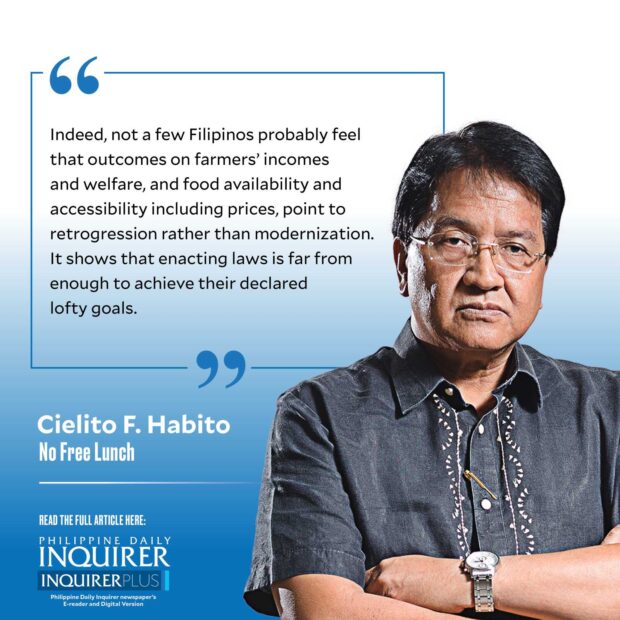Failed modernization

Over 26 years ago, Congress passed Republic Act No. 8435, known as the Agriculture and Fisheries Modernization Act or Afma. One would expect that two and a half decades later, we should be seeing palpable improvement and modernization in our farm and fisheries sector. But a recent assessment by the country’s foremost think tank, the Philippine Institute for Development Studies, asserts that our agriculture and fisheries (AF) sector remains far from modernized. Indeed, not a few Filipinos probably feel that outcomes on farmers’ incomes and welfare, and food availability and accessibility including prices, point to retrogression rather than modernization. It shows that enacting laws is far from enough to achieve their declared lofty goals. And in a country where laws have been cynically described as mere suggestions, Afma feels like a painful joke.
Over the weekend, I was at a lunch table with seasoned and venerable figures in Philippine agriculture ranging in age from the 70s to 90s, all of them fellow members of the Coalition for Agriculture Modernization in the Philippines (Camp). They all studied at the University of the Philippines Los Baños (UPLB), indisputably the country’s knowledge capital in agriculture, and devoted decades of their professional lives to pursuing the sector’s modernization. I posed to them the question: “Is Philippine agriculture now modern?” Not one answered in the affirmative.
National Scientist Dr. Emil Q. Javier clarified that there are “pockets of modernization” out there, and singled out the pineapple and banana export industries in Mindanao as examples. He was quick to note that our most modern agriculture industries appear to be those where government largely keeps its hands off. In stark contrast, those with the heaviest government intervention, namely rice, coconut, and sugar—all of which have distinct institutions focused on them—are the most backward and troubled. It seems a glaring anomaly that the more government gets involved in an industry, the worse it performs. For his part, biotechnology expert and champion Dr. Ben Peczon doesn’t see a coherent plan guiding our agricultural authorities’ actions. Others retorted that on the contrary, there have been numerous plans. But Camp president Dr. Eufemio Rasco, a major author of the National Agriculture and Fisheries Modernization and Industrialization Plan 2021-2030 or Nafmip, is wondering what happened to it, as nothing is being heard about it now from top agriculture officials.
Dr. Mario Labadan, whose company AgriSpecialist Inc. has long successfully put science to good use in industry, lamented how government itself is undermining his substantial missionary investment to commercialize UPLB’s proven Bio-N microbial fertilizer. He asks, “Where is the sense in government pushing farmers to favor imported fertilizers over far environmentally friendlier Bio-N, at three times the cost?” Someone cynically replied that there’s more money to be made (i.e., by less-than-honest officials) from large import procurements than from pushing homegrown inputs, even if demonstrably superior. Unfortunately, the DA’s checkered track record with procurement scandals over the years lends credibility to such naughty suspicions.
“How can our agriculture modernize, when the young people who would logically bring about modernization are turning away from the sector?” mused Dr. Fernando Bernardo, founding president of the Visayas State College of Agriculture (now the Visayas State University), and most senior in the group at 94. Rasco observed that young people venturing into technology-enabled agribusiness often are not even children of farmers, whose own offspring have only seen persistent poverty out of their parents’ occupation. But we may yet find hope in those innovative, nonfarm-raised young people who are finding exciting technology applications at all links of the value chain spanning finance (crowdfunding, other financial technologies for farmers); field production (soil sensors, drones, field robots); processing (robotics, artificial intelligence); transport, logistics, and tracking (Grab/Uber-type platforms, blockchain); and marketing (e-commerce, app-based farm-to-customer platforms).
All told, the group found consensus on three fundamental must-do’s: (1) consolidate our fragmented farms via cooperatives, contract growing, or even easing land ownership ceilings for agribusiness investors; (2) diversify our farms by shifting more attention and budgets well beyond the disproportionate share of rice; and (3) work through local governments by capacitating, empowering, and funding them to do the needed work on the ground that will lead our farmers into modernization. Even as it seems unlikely to happen within our aging group’s remaining lifetimes, hope always springs eternal.















